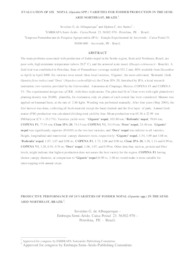Evaluation of six nopal (Opuntia spp.) varieties for fodder production in the semi-arid Northeast, Brazil.
Evaluation of six nopal (Opuntia spp.) varieties for fodder production in the semi-arid Northeast, Brazil.
Autoria: ALBUQUERQUE, S. G. de; SANTOS, D. C. dos
Resumo: The main problems associated with production of fodder nopal in the Sertão region, Semi-arid Northeast, Brazil, are poor soils, high minimum temperature (above 20.5o C), and the armored scale insect (Diaspis echinocacti - Bouchè). A field trial was established in Petrolina, State of Pernambuco ( average rainfall 552.2 mm, 80% available from December to April) in April 2000. Six varieties were tested: three local varieties, ?Gigante?, the most cultivated, ?Redonda? (both Opuntia ficus-indica) and ?Doce? (Nopalea cochenillifera); the Clone IPA-20, furnished by IPA, a local research institution; two varieties provided by the Universidad. Autonoma de Chapingo, Mexico, COPENA F1 and COPENA V1. The experimental design was a CRB , with three replications. The plots had 16 m2 (four rows with eight plants/row) planting density was 20.000, plants/ha, for evaluation, only six plants of each central line were considered Manure was applied on biannual basis, at the rate of 2.86 kg/m. Weeding was performed manually. After four years (May 2004), the first harvest was done, collecting all fresh material except the basal cladode and the first layer of pads.. Annual fresh matter (FM) production was calculated dividing total yield by four. Mean production was 65.36 ± 22.99 ton FM/ha/year (CV = 35.17%). Varieties yields were: ?Gigante? nopal, 103.80 ton; ?Redonda? nopal, 78.04 ton; COPENA F1, 77.54 ton; Clone IPA-20, 74.15 ton; COPENA V1, 34.19 ton; ?Doce? nopal, 24.40 ton. ?Gigante? nopal was significantly superior (P<0.05) to the two last varieties, and ?Doce? nopal was inferior to all varieties. Height, longitudinal and transversal canopy diameters were, respectively: ?Gigante? nopal, 1.54, 1.09 and 1.08 m; ?Redonda? nopal, 1.07, 1.07 and 0.98 m; COPENA F1, 1.73, 1.08 and 0.90 m; Clone IPA-20, 1.38, 1.11 and 0.99 m; COPENA V1, 1.28, 0.91, 0.76 m; ?Doce? nopal, 1.06, 1.07, and 0.99 m. Other data that, such as, protein and fiber levels, might indicate that highest production does not assure the best variety for the region. COPENA F1 having shorter canopy diameter, in comparison to ?Gigante? nopal (0.90 vs. 1.08 m) would make it more s
Ano de publicação: 2004
Tipo de publicação: Artigo em anais e proceedings
Unidade: Embrapa Semiárido
Palavras-chave: Gigante Nepal, Opuntia, Opuntia spp, Palma Forrageira, Produção, Região semi-árida, Variedade
Observações
1 - Por padrão são exibidas publicações dos últimos 20 anos. Para encontrar publicações mais antigas, configure o filtro ano de publicação, colocando o ano a partir do qual você deseja encontrar publicações. O filtro está na coluna da esquerda na busca acima.
2 - Para ler algumas publicações da Embrapa (apenas as que estão em formato ePub), é necessário ter, no celular ou computador, um desses softwares gratuitos. Sistemas Android: Google Play Livros; IOS: iBooks; Windows e Linux: software Calibre.
Acesse outras publicações
Acesse a Base de Dados da Pesquisa Agropecuária (BDPA) para consultar o acervo completo das bibliotecas da Embrapa.

